Rules for correctly laying membrane
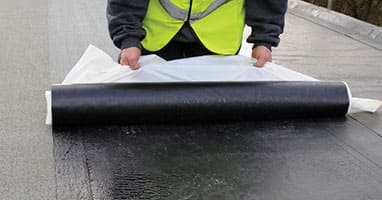
Laying out the sheets
Before laying, the rolls must be unrolled and aligned to layout the overlaps between the sheets. The sheets must then be rolled up again to proceed with the flame welding.
The end-to-end overlaps of the waterproof sheets must not be arranged along a single line but must always alternate.
The sheets must be arranged with overlaps as in tiling a roof, i.e. always starting the overlaps at the drains or the downpipes.
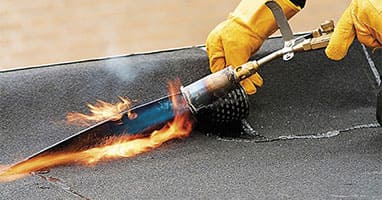
Lateral and end overlaps
Lateral: these are the joints that run in the direction of the length of the sheets. They must be welded with great care until a trickle of melted mixture about 1 cm wide can be seen coming out along the line of the overlap. The lateral overlaps must have a width of not less than 10 cm.
End: this refers to the joint along the shorter side of the sheet. This too is a point that requires close attention. The membrane must be melted until mastic runs out in the process of overlapping. The overlapped part should be not less than 15 cm wide.
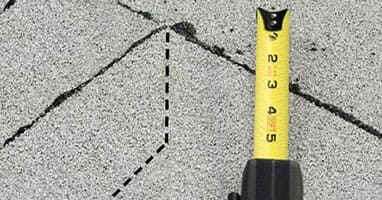
45° cut at end overlap
At the end overlap, a corner of the membrane measuring 10 cm per side must be cut off at an angle of 45°.
Sheets reinforced only with polyester non-woven fabric laid in semi-adhesion, in proximity to the end overlap, must be glued to the substrate at complete adhesion for a strip at least one meter wide.
The bonding operations will be facilitated if the sheets are wound around a rigid plastic tube (HDPE, ø 12 cm, length 97 cm) which will prevent ovalisation of the roll during laying, particularly in summer. At the same time, the pressure exerted on the roll will be uniformly discharged over the entire contact surface with the support, also facilitating the release of the melted mixture along the overlap lines, ensuring that the membrane is perfectly welded;
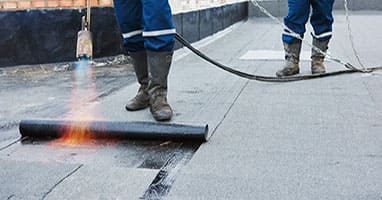
Application
Connecting the membrane to the substrate must be carried out as follows:
- In complete adhesion. The torching of the mixture of the rolls must heat the membrane and the substrate at the same time, concentrating on the roll.
- In semi-independence. Laying in semi-independence is performed by using the special Index specific membranes (PERFOBASE, VAPORDIFFUSER, DIFFUSER ALU, TECTENE REROOF BASE STRIP EP, MINERAL TECTENE REROOF STRIP EP), onto which the subsequent layers are bonded at complete adhesion.
- In independence. The membrane is unrolled "dry" onto the substrate, flame bonding only the overlaps. In this case, the waterproof membrane must always be ballasted (with flooring, gravel, soil etc,).
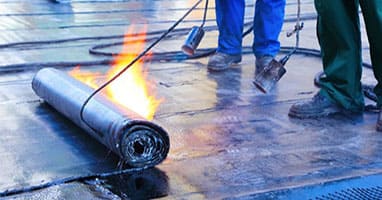
Double layer of membrane
If laying a second layer is specified, it must be laid so as to straddle the overlap of the previous layer and must be bonded at complete adhesion.
The burner flame must also heat the membrane already laid.
Always starting the overlaps at the drains or the downpipes.
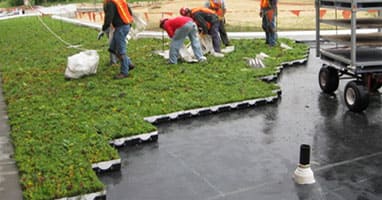
End overlap of mineral-coated membrane
At the end overlaps the mineral-coated surface must be heated with certain persistence so that melting consequently takes place over an area corresponding to the width of the overlap, with consequent melting of the bituminous mastic underneath.
Once the membrane compound which will form the overlap has been melted, this will enable the two edges to be welded perfectly.
How to select a waterproofing membrane?
Check for the following properties of the membrane:
- UV Stability- if the membrane is to be exposed to the sun, than it must be UV stable or UV resistant, else it will degrade over time.
- Elongation - this is the ability of the membrane to stretch. It is measured in percentages. Elongation of 150% means that the membrane can stretch to 1.5 times its length when pulled. Elongation is a must in buildings that will move, such as high-rise buildings, or buildings made with steel, which is flexible. This property will allow the membrane to stretch over cracks that may develop in the future. Membranes with elongation properties of over 200% are available.
- Breathability -one disadvantage of good waterproofing is that if water does happen to enter into the structure from a point and spread across a surface, that water is trapped inside the structure, and cannot get out. Breathable membranes help to release that water to the air in the form of water vapour. So some membranes are designed to prevent water from passing through them, while at the same time allowing water vapour to pass through. So over time, breathable membranes allow trapped water to evaporate into the atomosphere.
- Tear Resistance -this is an important property, as many membranes that have good elongation also can tear easily. Take a small sample of the material in your hand, and try and tear it into two pieces. This gives a fair idea of its tear resistance. You are looking for a membrane that will not tear even if a reasonable force is exerted on it.
- Abrasion Resistance -this is the ability of a membrane to withstand wear and tear. As most membranes are covered concrete screeds and tiling, the abrasion resistance comes into play during the construction period, when workers are walking on the surface, dropping nails and screws, and scraping hard objects like rebar against the membrane, which can damage it. A very soft membrane with low abrasion resistance may get damaged in such a situation, which can cause it to leak.
- Chemical stability - check that the membrane is chemically inert with respect to its environment in the building. Some membranes, especially outside basement walls, are exposed to the soil and rainwater outside.
- Food Safety - membranes can be applied to the inside of concrete water tanks to make them waterproof. In this case, the membrane must be food safe, as the water is in contact with the membrane.
- Geometry - if a membrane has to be installed over a complicated shape, such as the junction of a column and beam, then a liquid applied membrane is preferable, as it can be applied to any type of underlying shape or structure. A sheet membrane would form folds and creases and leave gaps between the underlay and membrane.





